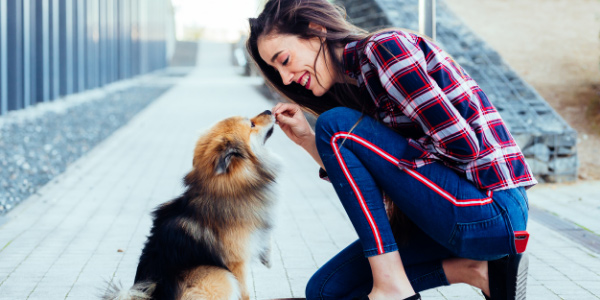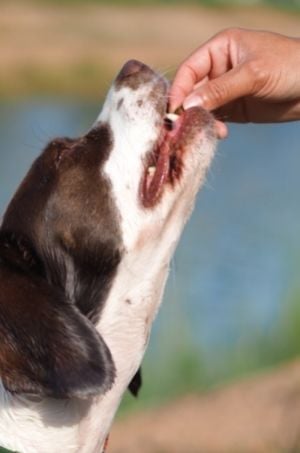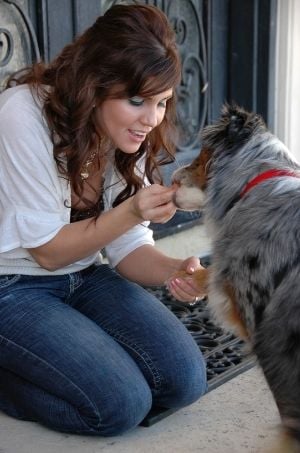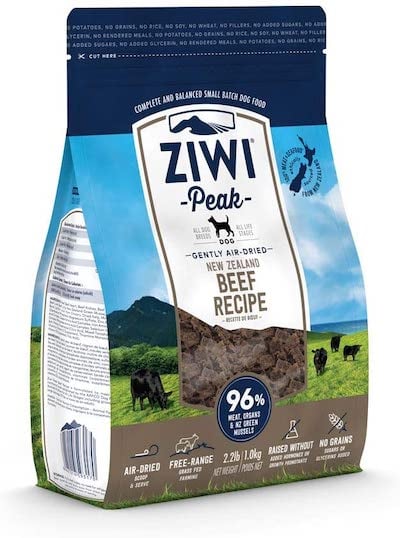 When you begin training your dog, it’s all about finding a reward that your dog is willing to work for. When we go to work, we expect a paycheck, and it’s only fair that we pay our dogs in their preferred currency for a job well done.
When you begin training your dog, it’s all about finding a reward that your dog is willing to work for. When we go to work, we expect a paycheck, and it’s only fair that we pay our dogs in their preferred currency for a job well done.
I don’t know about you, but I’d probably accept bacon as my preferred currency. Maybe that’s where the saying bringing home the bacon came from … but I don’t think bacon would pay the bills. (And please avoid giving your dog bacon ... it's a sure recipe for painful and expensive pancreatitis!)
Thankfully, almost every dog I’ve met is willing to do things for a piece of kibble, and even more excited to work for a little piece of chicken or cheese. You can take full advantage of your dog's desire for food if you go about it the right way. Treats are just one tool in our dog training toolkit and a very powerful one.
Will You Always Need to Use Treats?
 Short answer: yes. But you will use them less frequently in the future than when you first start teaching your dog a new skill or when you first introduce distractions. People ask me all the time if they'll always need training treats. It’s understandable if you’re worried about using treats when training your dog; you don’t want to always have to rely on having a treat in your pocket so your dog behaves. Just because you start with treats as the main reinforcement during your training sessions shouldn’t mean that you’ll always need them later on.
Short answer: yes. But you will use them less frequently in the future than when you first start teaching your dog a new skill or when you first introduce distractions. People ask me all the time if they'll always need training treats. It’s understandable if you’re worried about using treats when training your dog; you don’t want to always have to rely on having a treat in your pocket so your dog behaves. Just because you start with treats as the main reinforcement during your training sessions shouldn’t mean that you’ll always need them later on.
When you first begin, you'll be reinforcing your dog with a training treat for almost every repetition. But as you progress, you'll start incorporating real-life rewards rather than treats. Every so often, you'll still pay your dog for a job well done with a treat, so they continue to see the value in responding to your cues. You can learn more about the process of fading out training treats here.
No matter what type of reinforcement you use in dog training, whether that's food treats, toy rewards, or real-life rewards, you will always be competing with natural reinforcers in your dog's environment. The big, wide world is an interesting place for your pup. There are squirrels to chase, smells to sniff, other people and dogs, and more that your dog will find hard to ignore. Food treats help you show your dog that paying attention to you is worth ignoring those other interesting things.
Unfortunately, many dog owners give up on positive reinforcement training methods because of the myth that they’ll always need treats, or they’re never taught how to phase out treats in their training. It can and should be done!
This article will go over why food treats are important to use in training, how to avoid using food as a bribe, and how to ensure that your dog doesn’t become a two-ton-wonder-bun in the process. You’ll also learn how to choose the best treat for your dog and how to use treats effectively in your training journey.
Why You Should Use Dog Treats During Training
Food Treats Are a Powerful Reinforcer
Many dog owners like to believe that their dog will be willing to work for them because it makes them happy, and while many dogs do find owner approval and praise rewarding, it’s not quite as motivating as getting a piece of chicken. You don’t show up at work to make your boss feel good (although it is an added bonus). Your main motivation is getting paid so you can then pay your bills, buy groceries, save up for a vacation, or otherwise "treat yourself."
Food is used as a reinforcer when training your dog. A reinforcer is something that causes the frequency of an action (or inaction) to increase. For example, every time you reinforce a sit position with a reward, you are increasing the likelihood that your dog will sit more often. For the vast majority of dogs, the reward of choice is food.
Food drive (the willingness to work for food) is high in most dogs because food is considered a primary reinforcer. A primary reinforcer is something that your dog doesn’t need to learn how to like — food is something they need to survive! They are genetically programmed to figure out what behaviors get them food. Other primary reinforcers include water, air, sleep, sex, and shelter.
Food Treats Are Easy to Use
Treats are easy to give quickly to your dog when they perform a behavior. This means you can have a high number of repetitions in a short amount of time. This is important when first introducing a cue, or if you’re practicing in a group class environment. For example, if you’re rewarding your pup with a game of tug every time they come when called, it will take longer to perform ten repetitions than if you rewarded them with a small treat every time they were successful.
Training treats are also easily used as a lure when teaching your dog a new behavior. A lure is when you place a treat in your hand, close your fingers over it, and then use that hand in front of the dog’s nose to entice them to follow it. If you control a dog’s head (by engaging their nose — the smellier the better!), you can control their body, so a lure gives you a force-free way to move a dog into a certain position.
What’s important if using a lure in training your dog is switching to what’s called a prompt as soon as possible. A prompt is the same thing as a lure, except there is no food hidden in the hand. Many dogs get so used to following a lure that they will easily follow a hand motion prompt since they know it has always predicted something yummy happening to them.
When Is a Dog Treat a Bribe?
It’s important you don’t use food treats as a bribe when training your dog. At the very beginning of teaching a dog something new, you use food (as a lure) to make a behavior happen, and then switch to the behavior, making the food happen. This switch needs to happen as soon as possible in order to teach your dog that you won’t bribe them to perform behaviors. By fading out the hand lure as fast as possible, you will avoid a bribe. Keep the treat hidden until after they have performed the requested behavior.
What exactly is a bribe in dog training?
A bribe is when your dog refuses to respond to a previously taught cue until you show them you have a food treat.
Example: You ask your dog to Come, they don’t come. You walk into the kitchen, grab a piece of cheese, and show them you have it before calling them to Come again. This is a bribe.
Compare this to using food as a reinforcer. A reinforcer is your dog’s payment for a job well done. Your dog comes in hopes that coming when called will make a food treat happen, not because they saw that the treat was guaranteed.
At the beginning of training a new cue: The treat makes the behavior happen
Quickly changes to: The behavior makes the treat happen
How to Choose the Right Training Treat
Your dog gets to decide what treats they find rewarding — some dogs like crunchy, others like soft. Some dogs prefer vegetables over meat treats, just check out how excited this dog gets for his broccoli!
Offer your dog a few different options of treats and take note of which they get more excited for. A good high-value treat will catch your dog’s interest and keep their focus even with some distractions nearby. Find out how to give your dog a "treat taste test" in What Kind of Treats Should You Use to Train Your Dog.
There are plenty of types of treats to choose from: dry, semi-moist, freeze-dried, cooked, or raw. Soft treats usually work best for training sessions because your dog doesn’t need to take as much time to chew, and they are less likely to crumble and fall on the floor, which distracts your dog from the task at hand.
Once you have an idea of which kind of treat your dog values over others, you’re now able to use the level of treat as a score for your dog during training. Creating different grades of treats helps you fade out the use of treats in training down the road. More importantly, it helps your dog improve their training skills because you can give important feedback about the quality of their cue performance.
Avoid Making Your Dog Fat
It’s important to monitor your dog’s caloric intake when you start a training program, as dogs can pack on the pounds rather quickly! Being overweight can cause serious health issues for your dog. A general rule of thumb is that training treats shouldn’t be more than 10% of your dog’s daily food intake. Use our handy treat calculator to find out how many treats your dog should have each day.
Dog Daily Treat-Calorie Calculator
Daily Calories Your Dog Can
Have From Treats (approx.)
One of the best ways to prevent weight gain is to use your dog’s regular food as rewards. Most dogs will work for their kibble if they aren’t in an overly distracting environment, so use their regular food as much as possible for training.
You can make their regular food more enticing by mixing in a few pieces of moist, higher-value treats. The added Eau de hot dog makes their kibble much more exciting and worth working for. For my dogs' most-used training treats, I use the Ziwi Peak Air-Dried dog food. It's lower in calories than most treats and has balanced nutrition, so I can use more of them without worrying about skewing my dogs' nutrient intake.
If your dog finds their regular food too blasé but needs to limit their treat intake, there are many kinds of low-calorie dog treats.
You can also lower the amount of their regular meals to balance out the increase in treats. If you know that you’ll be going to puppy class and plan on using higher-value treats, reduce their meal by half so they don’t overdo it on those calories. Just be aware that your dog needs a complete and balanced diet. Training treats alone are not enough for your dog to thrive on.
Phasing Out the Use of Food Treats
It’s important to think about fading out training treats as your dog learns new things. You don’t want to always have to have treats available when your dog does something right! When your puppy is reliably performing a behavior about 90% of the time around mild distractions, you can start to fade out the use of food treats.
There are a few ways to go about doing this, such as using real-life rewards instead of food treats, giving different grades of treats based on how well your dog performed the behavior, and changing your reinforcement schedule. For an in-depth look at how to phase out the use of treats in dog training, check out this article.
Treats are a powerful training tool that you should have in your toolkit, but they can be misused. Food is a great motivator for our dogs; we just have to make sure we don’t bribe them to behave and have a plan to phase out the use of treats later down the road.






